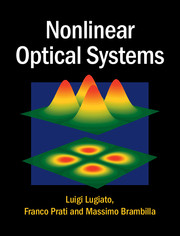Book contents
- Frontmatter
- Dedication
- Contents
- Preface
- Part I Models, propagation, stationary phenomena
- Part II Dynamical Phenomena, Instabilities, Chaos
- 18 Some general aspects in nonlinear dissipative dynamical systems
- 19 Special limits in the single-mode model
- 20 The linear-stability analysis of the Maxwell–Bloch equations
- 21 Adiabatic elimination in the complete Maxwell–Bloch equations
- 22 Dynamical aspects in the laser
- 23 Single-mode and multimode operation in inhomogeneously broadened lasers
- 24 Dynamical aspects in optical bistability
- 25 Self-pulsing in other optical systems
- Part III Transverse optical patterns
- Appendix A The Routh–Hurwitz stability criterion
- Appendix B Calculation of the oscillatory instability boundary
- Appendix C Coefficients of the characteristic equation (20.20)
- Appendix D Derivation of equations (20.27) and (20.28)
- Appendix E Coefficients of equations (20.60) and (20.61)
- Appendix F The exact boundary of the Risken–Nummedal–Graham–Haken instability
- Appendix G Nonlinear analysis of the roll solution
- References
- Index
22 - Dynamical aspects in the laser
from Part II - Dynamical Phenomena, Instabilities, Chaos
Published online by Cambridge University Press: 05 March 2015
- Frontmatter
- Dedication
- Contents
- Preface
- Part I Models, propagation, stationary phenomena
- Part II Dynamical Phenomena, Instabilities, Chaos
- 18 Some general aspects in nonlinear dissipative dynamical systems
- 19 Special limits in the single-mode model
- 20 The linear-stability analysis of the Maxwell–Bloch equations
- 21 Adiabatic elimination in the complete Maxwell–Bloch equations
- 22 Dynamical aspects in the laser
- 23 Single-mode and multimode operation in inhomogeneously broadened lasers
- 24 Dynamical aspects in optical bistability
- 25 Self-pulsing in other optical systems
- Part III Transverse optical patterns
- Appendix A The Routh–Hurwitz stability criterion
- Appendix B Calculation of the oscillatory instability boundary
- Appendix C Coefficients of the characteristic equation (20.20)
- Appendix D Derivation of equations (20.27) and (20.28)
- Appendix E Coefficients of equations (20.60) and (20.61)
- Appendix F The exact boundary of the Risken–Nummedal–Graham–Haken instability
- Appendix G Nonlinear analysis of the roll solution
- References
- Index
Summary
While the stationary behavior of the laser was described in Part I, now we focus on its dynamical aspects. Some of them have been illustrated already in Chapter 19, but only in the single-mode regime and for class-A and class-B lasers, in which the only instability which arises concerns the trivial stationary solution and leads to the transition from the non lasing to the lasing state. Chapter 20, on the other hand, provided a general picture of single-mode and multimode instabilities in active as well as in passive systems, and of the structural relations which link single-mode and multimode instabilities. In this chapter we focus on the instabilities which arise in the laser and lead to spontaneous temporal oscillations and chaos.
We start in Section 22.1 with the linear-stability analysis of the trivial stationary solution in the general multimode case for the standard laser. The results of this analysis have been anticipated in previous chapters, but here you will find their derivation. The same problem is considered in Section 22.2 for the laser without inversion, but limited to the single-mode case under fully resonant conditions as in Section 17.5.
Of fundamental importance is the analogy between the single-mode laser model and the Lorenz model, which is prototypical for the general field of chaos. This matter is discussed in Section 22.3, and is immediately followed by the treatment of the resonant single-mode laser instability in Section 22.4.
On the other hand, multimodal instabilities in the ring laser are discussed in Sections 22.5 and 22.6. The first is devoted to the amplitude instability, completing the picture given in Section 20.2, and the second to the phase instability. The multimode amplitude instability is related to a classic dynamical phenomenon in lasers, mode-locking, which topic is illustrated in Chapter 23.
Finally, Section 22.7 is devoted to the matter of amplitude instabilities again, but in the case of a Fabry–Perot laser containing an ultrathin medium discussed in Section 14.5.
- Type
- Chapter
- Information
- Nonlinear Optical Systems , pp. 252 - 274Publisher: Cambridge University PressPrint publication year: 2015



